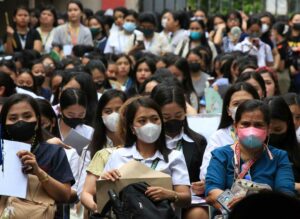Philippine jobless, underemployment rates jump in July

By Bernadette Therese M. Gadon, Researcher
The unemployment rate in the Philippines inched up to 4.8% in July, bringing the number of jobless Filipinos to 2.27 million, the Philippine Statistics Authority (PSA) said on Friday.
The underemployment rate, on the other hand, rose to a 20-month high as slower economic activity led to more job losses.
Preliminary results of the April Labor Force Survey (LFS) showed the unemployment rate rose to 4.8% in July from 4.5% in June. Year on year, this was lower compared to 5.2% in July 2022.
At 4.8%, this was the highest unemployment rate since 5% in September 2022, and matched the unemployment rate in January and February this year.
Despite the higher rate, the absolute number of jobless Filipinos in July was lower than the 2.33 million in June and 2.6 million in the same month last year, as the labor force shrank.
Year to date, the unemployment averaged 4.6%, lower than the 5.4% average a year ago.
PSA data also showed job quality deteriorated as the underemployment rate went up to 15.9% in July from 12% in June and 13.8% in July last year.
This is equivalent to 7.10 million underemployed Filipinos in July, higher than the 5.88 million in June and the 6.54 million recorded a year ago.
The 15.9% underemployment rate is the highest in 20 months or since the 16.6% in November 2021, PSA Undersecretary and National Statistician Claire Dennis S. Mapa said during the press conference.
“Invisible underemployment rose, which means more Filipinos are working 40 hours or more already, but they want to work more hours for additional income, or they want another job with higher pay,” he added.
Meanwhile, the employment rate dropped to 95.2% in July from 95.5% in the previous month, but higher than the 94.8% in the same month a year ago.
In absolute figures, 44.63 million Filipinos had jobs in July, down from the 48.84 million in the previous month. However, this is higher than the 47.39 million employed persons in July last year.
PSA data also showed the labor force size decreased by 4.27 million to 46.90 million in July from 51.17 million in June.
This put the country’s labor force participation rate (LFPR) at 60.1%, lower than the 66.1% and 65.2% in June and July 2021, respectively.
Analysts said the uptick in the jobless rate can be attributed to slower economic activity.
In an e-mail, ING Bank N.V. Manila senior economist Nicholas Antonio T. Mapa said that it was not surprising to see employment figures slip as high interest rates continue to dampen economic activity.
“A portion of the household may have left the labor force to accompany the kids back home. Supporting this is the fact that saw a steep decrease in those who are self-employed or who are unpaid family workers, jobs that are mostly associated with the informal sector,” HSBC economist for Association of Southeast Asian Nations (ASEAN) Aris Dacanay said
Average hours worked in a week rose to 42.3 hours in July from 40 hours in June, and 40.5 hours from a year ago.
The services sector remained the largest employer with 59.4% share, followed by agriculture with 21.5% and industry with 19%.
On a monthly basis, job losses were highest in the following industries: agriculture and forestry (8.14 million in July from 10.45 million in June), wholesale and retail trade, repair of motor vehicles and motorcycles (8.68 million from 10.08 million), and public administration and defense, compulsory social security (2.63 million from 2.99 million).
“The entire government remains committed to improving the business climate in the country to attract more investments, which will lead to the creation of high-quality and high-paying jobs,” said National Economic and Development Authority (NEDA) Secretary Arsenio M. Balisacan in a statement.
However, Sentro ng mga Nagkakaisa at Progresibong Manggagawa (SENTRO) Secretary-General Josua T. Mata said in a Viber message that elevated inflation may hinder job creation for the rest of the year.
“It will be more challenging to increase employment in the next months because of inflationary pressures. What the government can do is to maintain a strong stance on fiscal policy, make it more aggressive, if possible,” he said.
Mr. Mata said the government should introduce a robust public employment program that would directly generate jobs, like climate jobs.
“Climate jobs are those that would directly lower the carbon emission of the country. Examples are: developing renewable energy including manufacturing solar panels and turbines; coastal and riverine rehabilitation; serious reforestation; etc.,” he said.
HSBC’s Mr. Dacanay said that the government’s commitment to ramp up spending in the second half may improve employment numbers.
“Furthermore, the size of the labor force should increase once schooling begins as household members can return back to work to help make ends meet amid elevated inflation,” he said.
The April LFS was conducted from July 8 to 31, with a total of 170,859 sample households.




